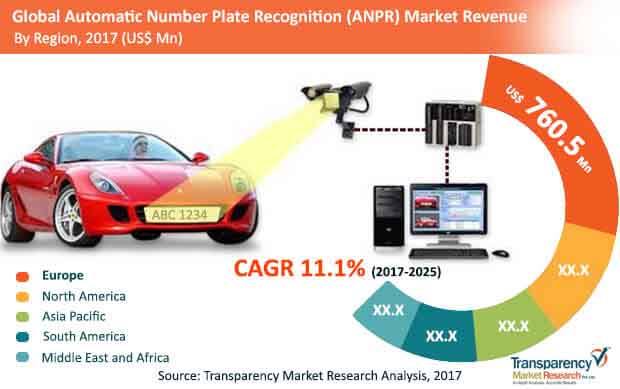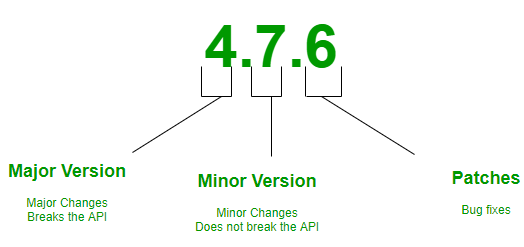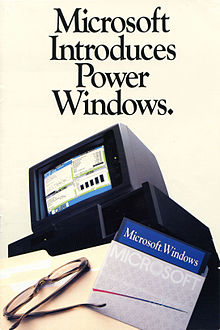
Market Research System 1.0.0 serial key or number

Market Research System 1.0.0 serial key or number
To generate these passwords you need to use KeyGen, a free application for Windows with which you can create secure passwords that will protect your accounts or encript your files and maintain your privacy.
This applicaiton is easy to use. You only have to configure "rules" to generate your password. These "rules" have the number of characters the password should have, the existence of capital and small letters in the same password or the appearance of special characters such as punctuation marks or accents.
All these features make KeyGen an excellent tool that is worth having.
- License
- Free
- Category
- Passwords
- Language
- English
- Author
- Red Zion
- Downloads
- 873,914
- Date
- 12.12.07
Introduction to Semantic Versioning
Semantic versioning (also referred as SemVer) is a versioning system that has been on the rise over the last few years. It has always been a problem for software developers, release managers and consumers. Having a universal way of versioning the software development projects is the best way to track what is going on with the software as new plugins, addons, libraries and extensions are being built almost everyday.
Semantic Versioning is a 3-component number in the format of X.Y.Z, where :
- X stands for a major version.
- Y stands for a minor version.
- Z stands for a patch.
So, SemVer is of the form Major.Minor.Patch.
Working : The goal of SemVer was to bring some sanity to the management of rapidly moving software release targets. As discussed above, 3 numbers i.e, Major, Minor and Patch are required to identify a software version. For example, if we take version 5.12.2, then it has a major version of 5, a minor version of 12 and a patch version of 2. Below given are the scenarios when you should bump the value of X, Y and Z.
- Bump the value of X when breaking the existing API.
- Bump the value of Y when implementing new features in a backward-compatible way.
- Bump the value of Z when fixing bugs.
Valid identifiers are in the set [A-Za-z0-9] and cannot be empty. Pre-release metadata is identified by appending a hyphen to the end of the SemVer sequence. Thus a pre-release for version 1.0.0 could be 1.0.0-alpha.1. Then if another build is needed, it would become 1.0.0-alpha.2, and so on. Note that names cannot contain leading zeros, but hyphens are allowed in names for pre-release identifiers.
Advantages of SemVer :
- You can keep track of every transition in the software development phase.
- Versioning can do the job of explaining the developers about what type of changes have taken place and the possible updates that should take place in the software.
- It helps to keep things clean and meaningful.
- It helps other people who might be using your project as a dependency.
Points to keep in mind :
- The first version starts at 0.1.0 and not at 0.0.1, as no bug fixes have taken place, rather we start off with a set of features as first draft of the project.
- Before 1.0.0 is only the Development Phase, where you focus on getting stuff done.
- SemVer does not cover libraries tagged 0.*.*. The first stable version is 1.0.0.
If you like GeeksforGeeks and would like to contribute, you can also write an article using contribute.geeksforgeeks.org or mail your article to contribute@geeksforgeeks.org. See your article appearing on the GeeksforGeeks main page and help other Geeks.
Please Improve this article if you find anything incorrect by clicking on the "Improve Article" button below.
Article Tags :
Windows 1.0
Windows 1.0 is a graphicalpersonal computeroperating environment developed by Microsoft. Microsoft had worked with Apple Computer to develop applications for Apple's January 1984original Macintosh, the first mass-produced personal computer with a graphical user interface (GUI) that enabled users to see user friendly icons on screen. Windows 1.0 was released on November 20, 1985, as the first version of the Microsoft Windows line. It runs as a graphical, 16-bitmulti-taskingshell on top of an existing MS-DOS installation. It provides an environment which can run graphical programs designed for Windows, as well as existing MS-DOS software. Its development was spearheaded by the company founder Bill Gates after he saw a demonstration of a similar software suite known as Visi On at COMDEX.
Despite positive responses to its early presentations and support from a number of hardware and software makers, Windows 1.0 was received poorly by critics. Critics felt Windows 1.0 did not meet their expectations. In particular, they felt that Windows 1.0 put too much emphasis on mouse input at a time when mouse use was not yet widespread; not providing enough resources for new users; and for performance issues, especially on systems with lower computer hardware specifications. Despite these criticisms, Windows 1.0 was an important milestone for Microsoft, as it introduced the Microsoft Windows line.[3] On December 31, 2001, Windows 1.0 was declared obsolete and Microsoft stopped providing support and updates for the system.
History[edit]
 | This section is missing information about the development and 2-year delay of Windows 1.0's release. Please expand the section to include this information. Further details may exist on the talk page.(June 2020) |

Microsoft began developing a graphical user interface (GUI) in 1981.[4] The development of Windows began after Microsoft founder Bill Gates saw a demonstration at COMDEX 1982 of VisiCorp's Visi On, a GUI software suite for IBM PC compatible computers.[5] In 1983 Microsoft learned that Apple's own GUI software—also bit-mapped, and based in part on research from Xerox PARC—was much more advanced; Microsoft decided they needed to differentiate their own offering.[4] In August 1983, Gates recruited Scott McGregor, one of the key developers behind PARC's original windowing system, to be the developer team lead for Windows 1.0[6][7][8]
Microsoft first presented Windows to the public on November 10, 1983.[9] Requiring two floppy disk drives and 192 KB of RAM, Microsoft described the software as a device driver for MS-DOS 2.0. By supporting cooperative multitasking in tiled windows when using well-behaved applications that only used DOS system calls, and permitting non-well-behaved applications to run in a full screen, Windows differed from both Visi On and Apple Computer's Lisa by immediately offering many applications. Unlike Visi On, Windows developers did not need to use Unix to develop IBM PC applications; Microsoft planned to encourage other companies, including competitors, to develop programs for Windows by not requiring a Microsoft user interface in their applications.[10]
Many manufacturers of MS-DOS computers such as Compaq, Zenith, and DEC promised to provide support, as did software companies such as Ashton-Tate and Lotus.[9] After previewing Windows, BYTE magazine stated in December 1983 that it "seems to offer remarkable openness, reconfigurability, and transportability as well as modest hardware requirements and pricing … Barring a surprise product introduction from another company, Microsoft Windows will be the first large-scale test of the desktop metaphor in the hands of its intended users".[10]
From early in Windows' history Gates viewed it as Microsoft's future. He told InfoWorld magazine in April 1984 that "Our strategies and energies as a company are totally committed to Windows, in the same way that we're committed to operating-system kernels like MS-DOS and Xenix. We're also saying that only applications that take advantage of Windows will be competitive in the long run."[11]IBM was notably absent from Microsoft's announcement,[9] and by late 1984, the press reported a "War of the Windows" between Windows, IBM's TopView, and Digital Research's Graphics Environment Manager (GEM).[12]
Microsoft had promised in November 1983 to ship Windows by April 1984,[9] but subsequently denied that it had announced a release date, and predicted that Windows would ship by June 1985. During its development and before its windowing system was developed, it was briefly referred to by the codename "Interface Manager".[13] Deemphasizing multitasking, the company stated that Windows' purpose, unlike that of TopView, was to "turn the computer into a graphics-rich environment" while using less memory.[12] After Microsoft persuaded IBM that the latter needed a GUI,[4] in April 1987 the two companies announced the introduction of OS/2 and its graphical OS/2 Presentation Manager, which were supposed to ultimately replace both MS-DOS and Windows.[14]
Release versions: Windows 1.01–1.04[edit]
Windows version 1.01, released on November 20, 1985, was the first public release of Windows.[15] The first international release, Windows version 1.02, was released in May 1986. Windows version 1.03, released in August 1986, included enhancements that made it consistent with the international release like drivers for European keyboards and additional screen and printer drivers. Windows version 1.04, released in April 1987, added support for the new IBM PS/2 computers, although no support for PS/2 mice or new VGA graphics modes was provided.[16] However, on May 27, 1987, an OEM version was released by IBM, which added VGA support, PS/2 mouse support, MCGA support, and support for the 8514/A display driver.[17][18] IBM released this version on three 3.5 inch 720k floppies, and offered it as part of their "Personal Publishing System" and "Collegiate Kit" bundles.[17]
Succession: Windows 2.0[edit]
In November 1987, Windows 1.0 was succeeded by Windows 2.0. Microsoft supported Windows 1.0 for 16 years, until December 31, 2001 – the longest out of all versions of Windows.[2]
Features[edit]

Windows 1.0 offers limited multitasking of existing MS-DOS programs and concentrates on creating an interaction paradigm (cf. message loop), an execution model and a stable API for native programs for the future. Due to Microsoft's extensive support for backward compatibility, it is not only possible to execute Windows 1.0 binary programs on current versions (albeit only 32-bit) of Windows to a large extent, but also to recompile their source code into an equally functional "modern" application with just limited modifications. Windows 1.0 is often regarded as a "front-end to the MS-DOSoperating system", a description which has also been applied to subsequent versions of Windows. Windows 1.0 is an MS-DOS program. Windows 1.0 programs can call MS-DOS functions, and GUI programs are run from .exe files just like MS-DOS programs. However, Windows .exe files had their own "new executable" (NE) file format, which only Windows could process and which, for example, allowed demand-loading of code and data. Applications were supposed to handle memory only through Windows' own memory management system, which implemented a software-based virtual memory scheme allowing for applications larger than available RAM.
Because graphics support in MS-DOS is extremely limited, MS-DOS applications have to go to the bare hardware (or sometimes just to the BIOS) to get work done. Therefore, Windows 1.0 included original device drivers for video cards, a mouse, keyboards, printers and serial communications, and applications were supposed to only invoke APIs built upon these drivers. However, this extended to other APIs such as file system management functions. In this sense, Windows 1.0 was designed to be extended into a full-fledged operating system, rather than being just a graphics environment used by applications. Indeed, Windows 1.0 is a "DOS front-end" and cannot operate without a DOS environment (it uses, for example, the file-handling functions provided by DOS.) The level of replacement increases in subsequent versions. The system requirements for Windows 1.01 constituted CGA/HGC/EGA (listed as "Monochrome or color monitor"), MS-DOS 2.0, 256 KB of memory or greater, and two double-sided disk drives or a hard drive.[1] Beginning with version 1.03, support for Tandy and AT&T graphics modes was added.

Windows 1.0 runs a shell program known as the MS-DOS Executive, which is little more than a mouse-able output of the DIR command that does not support icons and is not Y2K-compliant. Other supplied programs are Calculator, Calendar, Clipboard Viewer, Clock, Notepad, Paint, Reversi, Cardfile, Terminal and Write. Windows 1.0 does not allow overlapping windows. Instead all windows are tiled. Only dialog boxes can appear over other windows, but cannot be minimized.
Reception[edit]
Windows 1.0 was released to mixed reviews. Most critics considered the platform to have future potential, but that Windows 1.0 had not fulfilled expectations. Many reviews criticized its demanding system requirements, especially noting the poor performance experienced when running multiple applications at once, and that Windows encouraged the use of a mouse for navigation, a relatively new concept at the time.[5]The New York Times compared the performance of Windows on a system with 512 KB of RAM to "pouring molasses in the Arctic", and that its design was inflexible for keyboard users due to its dependency on a mouse-oriented interface. In conclusion, the Times felt that the poor performance, lack of dedicated software, uncertain compatibility with DOS programs, and the lack of tutorials for new users made DOS-based software such as Borland Sidekick (which could provide a similar assortment of accessories and multitasking functionality) more desirable for most PC users.[19]
In retrospect, Windows 1.0 was regarded as a flop by contemporary technology publications, who, however, still acknowledged its overall importance to the history of the Windows line.[3][5]Nathaniel Borenstein (who went on to develop the MIME standards) and his IT team at Carnegie Mellon University were also critical of Windows when it was first presented to them by a group of Microsoft representatives. Underestimating the future impact of the platform, he believed that in comparison to an in-house window manager, "these guys came in with this pathetic and naïve system. We just knew they were never going to accomplish anything."[20]The Verge considered the poor reception towards the release of Windows 8 in 2012 as a parallel to Microsoft's struggles with early versions of Windows. In a similar fashion to Windows 1.0 running atop MS-DOS as a layer, Windows 8 offered a new type of interface and software geared towards an emerging form of human interface device on PCs, in this case, a touchscreen, running atop the legacyWindows shell used by previous versions.[5]
A mock version of Windows 1.0 was created by Microsoft as an app for Windows 10 as part of a tie-in with the Netflix show, Stranger Things, aligned with the release of the show's third season, which takes place during 1985.[21]
See also[edit]
References[edit]
- ^ abc"Windows Version History". Support (4.0 ed.). Microsoft. September 23, 2011. Archived from the original on November 7, 2006.
- ^ ab"Obsolete Products". Support. Microsoft. July 25, 2011. Archived from the original on August 14, 2005.
- ^ abCooper, Charles (November 20, 2013). "Windows 1.0: The flop that created an empire". CNET. CBS Interactive.
- ^ abcAlsop, Stewart II (January 18, 1988). "Microsoft Windows: Eclectism in UI"(PDF). P.C. Letter. 4 (2): 6–7.
- ^ abcdHollister, Sean (November 20, 2012). "Revisiting Windows 1.0: how Microsoft's first desktop gracefully failed". The Verge. Vox Media. Retrieved January 21, 2017.
- ^Wallace, James; Erickson, Jim (June 1, 1993). Hard Drive: Bill Gates and the Making of the Microsoft Empire. Harper Business. ISBN .
- ^Hey, Tony; Pápay, Gyuri (December 8, 2014). The Computing Universe: A Journey Through a Revolution. Cambridge University Press. p. 157. ISBN .
- ^Caruso, Denise (May 7, 1984). "An Update on Windows: Developers to get package later this month". InfoWorld. Vol. 6 no. 19. p. 52. Retrieved June 20, 2020.
- ^ abcdMarkoff, John (November 21, 1983). "Microsoft Does Windows". InfoWorld. Menlo Park, CA: Popular Computing. 5 (47): 32–36. ISSN 0199-6649.
- ^ abLemmons, Phil (December 1983). "Microsoft Windows". BYTE. p. 48.
- ^Caruso, Denise (April 2, 1984). "Company Strategies Boomerang". InfoWorld. pp. 80–83. Retrieved February 10, 2015.
- ^ abRosch, Winn L. (December 25, 1984). "The Curtain Rises On The War of the Windows". PC Magazine. p. 33. Retrieved October 25, 2013.
- ^Hanson, Rowland. "WINDOWS IS NAMED WINDOWS : BUT WHY?".
- ^"A history of Windows". support.microsoft. Microsoft. 2012. Archived from the original on November 17, 2012.
- ^"Windows - Virtual x86".
- ^"Windows 1". Winhistory.de (in German).
- ^ ab"Version 1 for IBM PS/2". win1.krnl386.com. Retrieved April 12, 2019.
- ^"IBM PS2 OEM Microsoft Windows 1.04 - 720k". archive.org. Retrieved April 12, 2019.
- ^Sandberg-Diment, Erik (February 25, 1986). "Personal Computers; Windows Are Open At Last". The New York Times. Retrieved November 11, 2013.
- ^Brodkin, Jon (2010-11-08). "Windows 1.0 turning 25: First experiences recalled". NetworkWorld. Archived from the original on November 10, 2010. Retrieved November 11, 2013.
- ^Warren, Tom (July 8, 2019). "Microsoft's new Windows 1.11 app is a Stranger Things trip back to 1985". The Verge. Retrieved July 8, 2019.
External links[edit]
What’s New in the Market Research System 1.0.0 serial key or number?
Screen Shot

System Requirements for Market Research System 1.0.0 serial key or number
- First, download the Market Research System 1.0.0 serial key or number
-
You can download its setup from given links:


